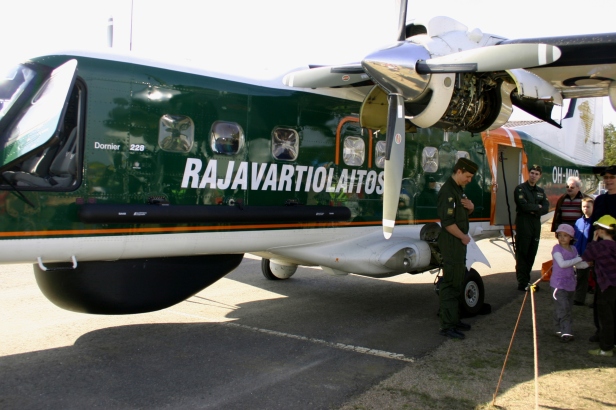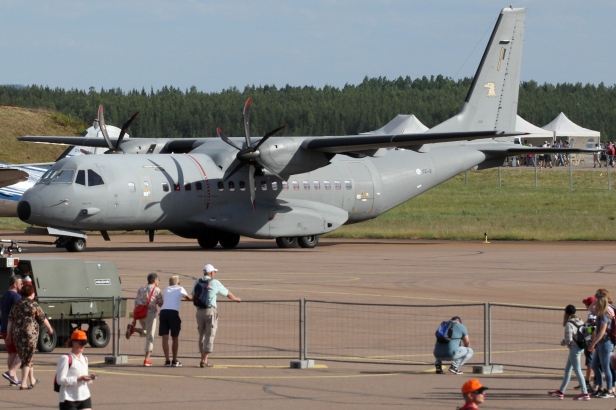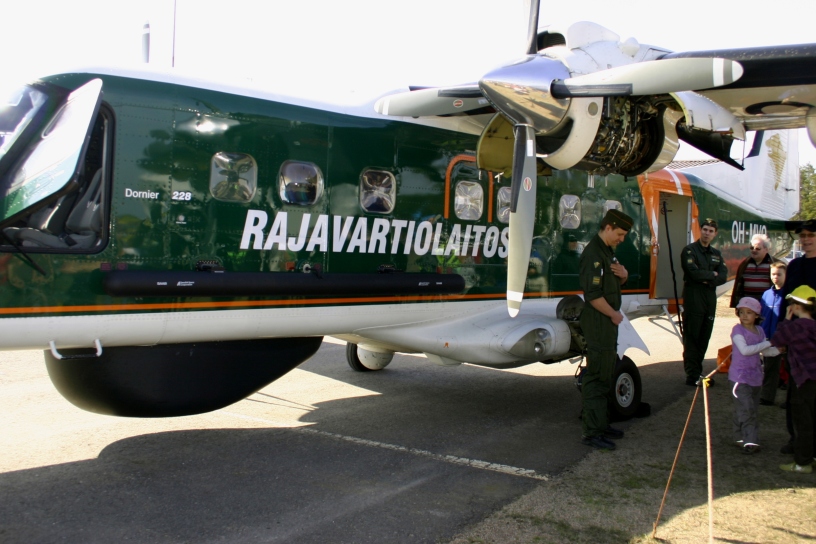A small note in the Finnish government programme hot off the press is the first official schedule for a small but interesting aircraft procurement programme.
The capability of the Border Guard in a changing environment is ensured. The Border Guard technical surveillance systems and two aircraft are being replaced by 2022.
Own translation
The two aircraft in question are two Dornier Do 228-212 built in 1995 and in Finnish Border Guard service as maritime surveillance platforms ever since. At the heart of their capabilities are the Swedish MSS 6000 system, which integrate sensors, communication equipment, and two operator consoles. Following a mid-life update in 2009-2013 and further upgrades back in 2017, the main sensors are two radars (a 360° search radar in the front underfuselage bulb as well as a side-looking radar, SLAR, on the fuselage side), electro-optical sensors (with a laser illuminator), AIS, and a radio direction finder. Handheld cameras are also integrated into the system.

The aircraft are completely unarmed, and as the rest of the Border Guard organisation they sort under the Ministry of Interior in peacetime, but are transferred to the Finnish Defence Forces in times of war. Much of their peacetime duties are centred around peaceful missions such as looking for oil spill, fisheries protection, counting seals, and border surveillance. More high-profile missions the aircraft have been part of are deployments at the EU’s southern border as part of FRONTEX, and a showing by OH-MVO during the raid on Airiston Helmi last year.
The Finnish Navy unsurprisingly lack a naval aviation branch, and neither does the Air Force have much in the way of maritime surveillance capabilities. The three Learjets operated are sometimes seen with a 360° search radar, but are few in numbers and also heavily tasked with numerous other missions. As such the Dorniers are a vital source of information whenever the Navy wants to know what’s on the other side of the horizon.
Especially in the grey zone of heightened tension but below the threshold of war, maintaining an accurate situational picture of the movements in the northern Baltic Sea and Gulf of Finland would be crucial, and here the cooperation between the flying units of the Border Guard and the Navy would come into play. Note that these kinds of periods potentially could last months.
So what could replace the Dorniers? To begin with we need to kill the idea that HX could do it. The HX winner will undoubtedly feature vastly superior sensors compared to the current Hornet-fleet, including when it comes to the maritime domain. However, loitering time is low compared to dedicated platforms, and having a nose-mounted radar means you need to be flying roughly in the direction of the target to keep your most important all-weather sensors on it. The lack of a dedicated mission crew, though possible to handle with a backseater in some HX-candidates, is also a drawback. As such, a dedicated platform is going to offer superior intelligence gathering capabilities, especially if you want to stand back from the action. Using unarmed platforms also lessen the provocative aspect.
The same can be given as the reason why the two GlobalEye included in Saab’s HX-package won’t replace the need for Border Guard fixed-wing aviation. The service has been clear that they want civilian unarmed aircraft, as these will significantly ease international cooperation. Also, while the GlobalEye has significant maritime surveillance capabilities, in the same way as with the Learjets their main use would be something else, in this case assisting the Air Force in the battle for air superiority. All in all, while they would assist in maintaining the maritime picture, in wartime the need for a Dornier-replacement would still present itself. The whole GlobalEye-package is enough of a bombshell to warrant a post of it’s own.

The most prolific maritime patrol aircraft today is the Boeing P-8 Poseidon, coming in at well over ten times the maximum take-off weight of the 6.5 ton Do 228. Needless to say, it is way too large and complex for the Rajavartiolaitos. The ATR 42MP is a tried and tested design, and is found in configurations close to what we need. However, it is still almost three times the size of the Do 228. The C295 Persuader is another surveillance version of an aircraft of the same size as the ATR 42, however it has the benefit of commonality with the transport fleet of the Finnish Air Force. This could potentially be a winning factor, promising fewer surprises and maintenance synergies. Yes, there’s a C-27J based MPA as well, but in Finnish service that offers the drawbacks of the Persuader without it’s benefits.
A really interesting contender is the light twin-engined Diamond DA62-MSA. This was recently unveiled, and although smaller than the Do 228, still offer a four person crew and an impressive sensor and mission suite. A yet more radical choice would be the Northrop Grumman MQ-4C Triton, which is a large maritime surveillance drone, based on the more widely used RQ-4 Global Hawk. Is the Border Guard prepared to go unmanned for their most important maritime surveillance platform? Probably not, but it remain a possibility. Granted, there are also some other, some rather stylish, alternatives, but I would be surprised if the eventual winner isn’t found amongst those above.


Buy more Globaleye, that would solve the problem of main and secondary missions. however if we look at size, I think the Saab MSA/MPA (340/2000) version for maritime patrol would be the best fit.
What often drives cost for small countries like Denmark and Finland is not one plane, but the service setup for a plane type. So the more you can get one type to do, the more roles the same airframe can do, the less it’ll cost to keep flying.
What the Finnish air force, navy and border-guard should look into, is to go with Saabs Swordfish concept on the Bombardier Global 6000 biz jet platform in a unarmed version. Because it is on a bizjet platform it will be rather cheap to run and maintain and has good uptime, but initial costs will be higher than the a Dorier style replacement. However I will argue that due to the long distances in Finland, it should make sense to go with the faster 6000 platform. Connect the C2 systems with the C2 systems on the new ships and HX especially if that is F35s, and it begins to look like something, where situation pictures and C2 are shared between units.
What can bring costs down, is that the Learjet will need replacing sometime, and replacing them with 4 Global 6000 bizjets will reduce the number of platforms from two to one, as the basic plane is the same for 90%. That’ll reduce maintenance costs.
If Finland later buys a pair of GlobalEye, they will fit right into as well.
In Denmark we have the same challenge. We have 4 Bombardier Challenger 604 that have just gotten their MLU. Three is configured as MPA light and one as VIP/transport. They don’t have the same capability as the Swordfish. We should also get the Swordfish but armed, for the MPA role, and two VIP/transport Global 6000 planes. That’ll increase the capabilities and keep the number of platforms the same. The hole in 604 are that they cannot work together with shared information to the F35s or the ships or other units.
using manned planes for this job is a waste of money (persistent surveillance)
they are too expensive and too short endurance for use
and in wartime they would need big vanurble airfields to be deployed from
(bad for finnish threat scenario)
the tryton and the poseidon are oceanic ultra long range 100 million + per system anti submarine hunters good for australia irrelevant for finland
what you need is cheap long endurance drones with naval sensors
we scraped our old king air mpa for navalized iai herons last year
works great
some of our friends (notebly chile) use the hermes 900 for the same functions
flight hour of heron is less then a third the price of the king air and no one will die if it is shot down